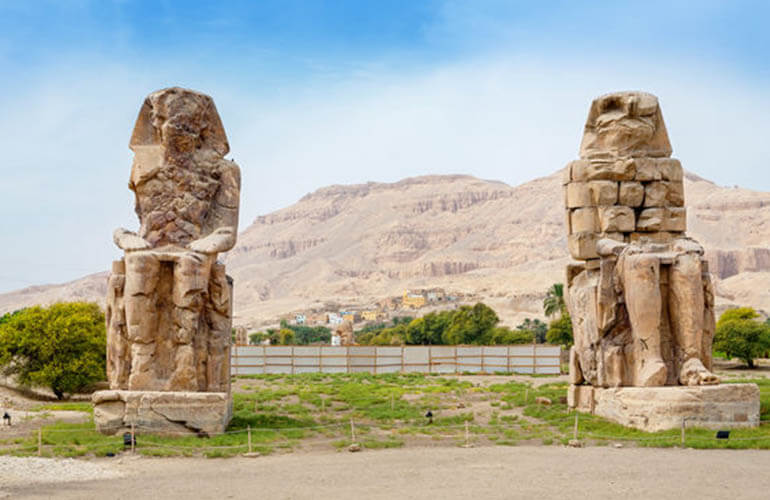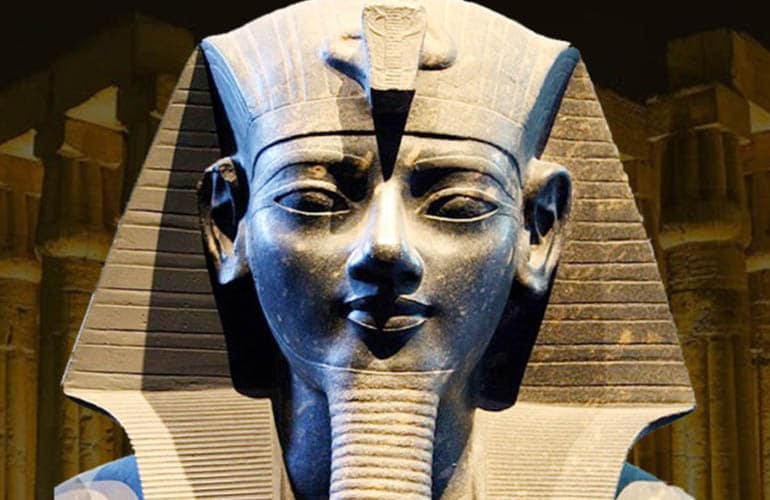The Colossi of Memnon, Luxor:
The Colossi of Memnon, located on the western shore of Luxor, are among the most emblematic and attractive monuments bequeathed by the Pharaonic civilization.
Located in the vicinity of Medinet Habu, The Colossi of Memnon are the only visible remains of the funerary temple of Amenhotep III that was in the area.

The Colossi of Memnon was created during the reign of Amenhotep III (1386-1349 B.C.) and these two large stone masses are large scale representations of this monarch, whose reign was a time of splendour and when the arts reached a high point.
The king is shown in an enthroned position with his hands resting on his legs, wearing the nemes headdress, so characteristic of the Egyptian monarchy, and one can still guess at the shape of the protective cobra standing on his forehead.

Both giants are about 14 meters high, and each weighs an estimated 700 tons. To these dimensions we must add the pedestals on which they stand, which are almost 4 meters high, weighing approximately 600 tons. So the whole of each colossus on its respective pedestals reaches a height of 18 meters, being the northern colossus slightly larger. If we add to this the missing part of the heads and the headdresses, which are not completely preserved, possibly the total height should be close to 21 meters.
The sculptures were made by architect Men in a single block of quartzite. This material was possibly extracted from the quarries of Gebel el-Ahmar, near Cairo. The figures marked the entry point to the funerary temple of Amenhotep III. This was the ninth pharaoh of the 18th dynasty and reigned in ancient Egypt some 3,4000 years ago.
This temple stretched for almost a kilometer in length and was, therefore, a huge center of worship in which the pharaoh was worshipped as a god on earth. In fact, the temple complex was the largest and most spectacular in all of Egypt, surpassing even the Karnak temple in size.
The side panels, on each side of The Colossi of Memnon, keep inscriptions among which the hieroglyphs with the protocol of the pharaoh stand out, repeating their cartouches. However, what is most striking are the bas-reliefs that show the Hapi (Nile god), emblem of the abundance and gifts of the Nile, symbol of the union of Upper and Lower Egypt.
This is a very traditional iconography, especially recurrent in the representation of pharaohs’ thrones, and which underlines the dual authority over the two great territories of Egypt.
Although it was a formidable work, the Temple of Amenhotep III a lot of Years has been badly preserved and the passage of time has practically made it disappear, a victim of earthquakes, the reuse of its elements, the use as a quarry… In addition, parts of its structure were built with adobe, a constructive element that time and floods have punished here intensely.
An earthquake in 27 BC damaged the giants of Memnon. Since then, it was said that the statues “sang” every morning at dawn, This sound has been described as a groaning or singing, a kind of noise that seemed to be produced by the cracks in the stones that make up the sound and which, as soon as it was repaired, disappeared.
Like many other monuments, such as the great sphinx of Giza, the giants of Thebes attracted admiration, but they were also the objects of legend and horror, especially in the dark Middle Ages that lasted until the beginning of the 19th century in Egypt.
Local traditions accuse the Mamluk soldiers of having mutated the face and body parts of the statues by shooting them with cannons. Since the 18th century, and especially since the Egyptian Expeditions.





